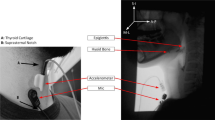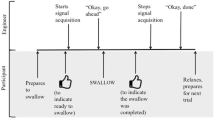Abstract
High-resolution cervical auscultation (HRCA) is an emerging method for non-invasively assessing swallowing by using acoustic signals from a contact microphone, vibratory signals from an accelerometer, and advanced signal processing and machine learning techniques. HRCA has differentiated between safe and unsafe swallows, predicted components of the Modified Barium Swallow Impairment Profile, and predicted kinematic events of swallowing such as hyoid bone displacement, laryngeal vestibular closure, and upper esophageal sphincter opening with a high degree of accuracy. However, HRCA has not been used to characterize swallow function in specific patient populations. This study investigated the ability of HRCA to differentiate between swallows from healthy people and people with neurodegenerative diseases. We hypothesized that HRCA would differentiate between swallows from healthy people and people with neurodegenerative diseases with a high degree of accuracy. We analyzed 170 swallows from 20 patients with neurodegenerative diseases and 170 swallows from 51 healthy age-matched adults who underwent concurrent video fluoroscopy with non-invasive neck sensors. We used a linear mixed model and several supervised machine learning classifiers that use HRCA signal features and a leave-one-out procedure to differentiate between swallows. Twenty-two HRCA signal features were statistically significant (p < 0.05) for predicting whether swallows were from healthy people or from patients with neurodegenerative diseases. Using the HRCA signal features alone, logistic regression and decision trees classified swallows between the two groups with 99% accuracy, 100% sensitivity, and 99% specificity. This provides preliminary research evidence that HRCA can differentiate swallow function between healthy and patient populations.



Similar content being viewed by others
References
Suiter DM, Sloggy J, Leder SB. Validation of the yale swallow protocol: a prospective double-blinded videofluoroscopic study. Dysphagia. 2014;29(2):199–203. https://doi.org/10.1007/s00455-013-9488-3.
Groves-Wright KJ, Boyce S, Kelchner L. Perception of wet vocal quality in identifying penetration/aspiration during swallowing. J Speech Lang Hear Res. 2009;53(3):620–32. https://doi.org/10.1044/1092-4388(2009/08-0246).
Waito A, Bailey GL, Molfenter SM, Zoratto DC, Steele CM. Voice-quality abnormalities as a sign of dysphagia: validation against acoustic and videofluoroscopic data. Dysphagia. 2011;26(2):125–34. https://doi.org/10.1007/s00455-010-9282-4.
Dudik JM, Coyle JL, Sejdic E. Dysphagia screening: contributions of cervical auscultation signals and modern signal-processing techniques. IEEE Trans Hum Mach Syst. 2015;45(4):465–77. https://doi.org/10.1109/THMS.2015.2408615.
Sejdic E, Steele CM, Chau T, Member S. Classification of penetration–aspiration versus healthy swallows using dual-axis swallowing accelerometry signals in dysphagic subjects. IEEE Trans Biomed Eng. 2013;60(7):1859–66. https://doi.org/10.1109/TBME.2013.22437.
Dudik JM, Jestrovic I, Luan B, Coyle JL, Sejdic E. A comparative analysis of swallowing accelerometry and sounds during saliva swallows. Biomed Eng Online. 2015;14(3):1–15. https://doi.org/10.1186/1475-925X-14-3.
Dudik JM, Kurosu A, Coyle JL, Sejdic E. A comparative analysis of DBSCAN, K-means, and quadratic variation algorithms for automatic identification of swallows from swallowing accelerometry signals. Comput Biol Med. 2015;59:10–8. https://doi.org/10.1016/j.compbiomed.2015.01.007.
Jestrovic I, Dudik JM, Luan B, Coyle JL, Sejdic E. Baseline characteristics of cervical auscultation signals during various head maneuvers. Comput Biol Med. 2014;43(12):2014–20. https://doi.org/10.1016/j.compbiomed.2013.10.005.
Movahedi F, Kurosu A, Coyle JL, Perera S, Sejdic E. Computer methods and programs in biomedicine: a comparison between swallowing sounds and vibrations in patients with dysphagia. Comput Methods Prog Biomed. 2017;144:179–87. https://doi.org/10.1016/j.cmpb.2017.03.009.
Dudik JM, Coyle JL, El-Jaroudi A, Mao ZH, Sun M, Sejdić E. Deep learning for classification of normal swallows in adults. Neurocomputing. 2018;285:1–9. https://doi.org/10.1016/j.neucom.2017.12.059.
Martin-Harris B, Brodsky MB, Michel Y, et al. MBS measurement tool for swallow impairment-MBSimp: establishing a standard. Dysphagia. 2008;23(4):392–405. https://doi.org/10.1007/s00455-008-9185-9.
Donohue C, Zhenwei Z, Mahoney A, Perera S, Sejdic E, Coyle J. Do machine ratings of hyoid bone displacement during videofluoroscopy match clinician ratings using the MBSImP? Poster presented at: The American Speech-Language Hearing Association Annual Meeting; November, 2018; Boston, MA, United States.
Donohue C, Khalifa Y, Sejdic E, Coyle J. How closely do machine ratings of duration of UES during videofluoroscopy approximate clinician ratings using the MBSImP? Poster presentation at: The Dysphagia Research Society annual meeting; March, 2019; San Diego, CA, United States.
Sabry A, Mahoney A, Perera S, Sejdic E, Coyle J. Are HRCA signal features associated with clinical ratings of pharyngeal reidue using the MBSImP? Poster presented at: The Dysphagia Research Society Annual Meeting; March, 2019; San Diego, CA, United States.
Rebrion C, Zhang Z, Khalifa Y, et al. High-resolution cervical auscultation signal features reflect vertical and horizontal displacements of the hyoid bone during swallowing. IEEE J Transl Eng Heal Med. 2019;7:1800109. https://doi.org/10.1109/JTEHM.2018.2881468.
Zhang Z, Coyle JL, Sejdić E. Automatic hyoid bone detection in fluoroscopic images using deep learning. Sci Rep. 2018;8(1):1–9. https://doi.org/10.1038/s41598-018-30182-6.
He Q, Perera S, Khalifa Y, Zhang Z, Mahoney A, Sabry A, Donohue C, Coyle J, Sejdic E. The association of high-resolution cervical auscultation signal features with hyoid bone displacement during swallowing. IEEE Trans Neural Syst Rehabil Eng. 2019;27(9):1810–6. https://doi.org/10.1109/TNSRE.2019.2935302.
Mao S, Zhenwei Z, Khalifa Y, Donohue CJL, Sejdic E. Neck sensor-supported hyoid bone movement tracking during swallowing. R Soc Open Sci. 2019. https://doi.org/10.1098/rsos.181982.
Kurosu A, Coyle JL, Dudik JM, Sejdic E. Detection of swallow kinematic events from acoustic high-resolution cervical auscultation signals in patients with stroke. Arch Phys Med Rehabil. 2019;100(3):501–8. https://doi.org/10.1016/j.apmr.2018.05.038.
Sabry A, Shitong M, Mahoney A, Khalifa Y, Sejdic E, Coyle J. Automatic estimation of laryngeal vestibular closure duration using high resolution cervical auscultation signals. Poster presented at: The American Speech-Language Hearing Association Convention; November, 2019; Orlando, FL, United States.
Khalifa Y, Donohue C, Coyle JL, Sejdic E. Upper esophageal sphincter opening segmentation with convolutional recurrent neural networks in high resolution cervical auscultation. IEEE J Biomed Inform. 2020. https://doi.org/10.1109/JBHI.2020.3000057.
da Costa FA, Mourao LF. Dysarthria and dysphagia in amyotrophic lateral sclerosis with spinal onset: a study of quality of life related to swallowing. NeuroRehabilitation. 2015;36(1):127–34.
Paris G, Martinaud O, Petit A, et al. Oropharyngeal dysphagia in amyotrophic lateral sclerosis alters quality of life. J Oral Rehabil. 2012;40(3):199–204.
Tabor L, Gaziano J, Watts S, Robison R, Plowman EK. Defining swallowing-related quality of life profiles in individuals with amyotrophic lateral sclerosis. Dysphagia. 2016;31(3):376–82.
Schwartz DB. Enteral nutrition and dementia: Integrating ethics. Nutr Clin Pract. 2018;33(3):377–87. https://doi.org/10.1002/ncp.10085.
Alali D, Ballard K, Bogaardt H. The frequency of dysphagia and its impact on adults with multiple sclerosis based on patient-report questionnaires. Mult Scler Relat Disord. 2018;25:227–31. https://doi.org/10.1016/j.msard.2018.08.003.
Leow LP, Huckabee ML, Anderson T, Beckert L. The impact of dysphagia on quality of life in ageing and parkinson’s disease as measured by the Swallowing Quality of Life (SWAL-QOL) questionnaire. Dysphagia. 2010;25(3):216–20. https://doi.org/10.1007/s00455-009-9245-9.
Waito AA, Valenzano TJ, Peladeau-pigeon M, Steele CM. Trends in research literature describing dysphagia in motor neuron Diseases (MND): a scoping review. Dysphagia. 2017;32(6):734–47. https://doi.org/10.1007/s00455-017-9819-x.
Audag N, Goubau C, Toussaint M, Reychler G. Screening and evaluation tools of dysphagia in adults with neuromuscular diseases: a systematic review. Ther Adv Chronic Dis. 2019;10:1–15. https://doi.org/10.1177/2040622318821622.
Takahashi K, Groher ME, Michi K. Methodology for detecting swallowing sounds. Dysphagia. 1994;9(1):54–62. https://doi.org/10.1007/BF00262760.
Shrout PE, Fleiss JL. Intraclass correlations: uses in assessing rater reliability. Psychol Bull. 2005;86(2):1–9.
Sejdić E, Steele CM, Chau T. The effects of head movement on dual-axis cervical accelerometry signals. BMC Res Notes. 2010;3:269. https://doi.org/10.1186/1756-0500-3-269.
Sejdić E, Steele CM, Chau T. A method for removal of low frequency components associated with head movements from dual-axis swallowing accelerometry signals. PLoS ONE. 2012;7(3):1–8. https://doi.org/10.1371/journal.pone.0033464.
Yu C, Khalifa Y, Sejdic E. Silent aspiration detection in high resolution cervical auscultations. In: 2019 IEEE EMBS intconf biomed heal informatics; 2019. https://doi.org/10.1109/bhi.2019.8834576.
Acknowledgements
People: Thanks to Tara Smyth, BA, and Dan Kachnycz, BA for assistance with data collection and coding.
Funding
Research reported in this publication was supported by the Eunice Kennedy Shriver National Institute of Child Health & Human Development of the National Institutes of Health under Award Number R01HD092239, while the data were collected under Award Number R01HD074819. The content is solely the responsibility of the authors and does not necessarily represent the official views of the National Institutes of Health or National Science Foundation.
Author information
Authors and Affiliations
Corresponding author
Ethics declarations
Conflict of interest
We have no conflicts of interest to declare.
Ethical Approval
All procedures performed in studies involving human participants were in accordance with the ethical standards of the institutional and/or national research committee and with the 1964 Helsinki declaration and its later amendments or comparable ethical standards.
Informed Consent
Informed consent was obtained from all individual participants included in the study.
Additional information
Publisher's Note
Springer Nature remains neutral with regard to jurisdictional claims in published maps and institutional affiliations.
Rights and permissions
About this article
Cite this article
Donohue, C., Khalifa, Y., Perera, S. et al. A Preliminary Investigation of Whether HRCA Signals Can Differentiate Between Swallows from Healthy People and Swallows from People with Neurodegenerative Diseases. Dysphagia 36, 635–643 (2021). https://doi.org/10.1007/s00455-020-10177-0
Received:
Accepted:
Published:
Issue Date:
DOI: https://doi.org/10.1007/s00455-020-10177-0




